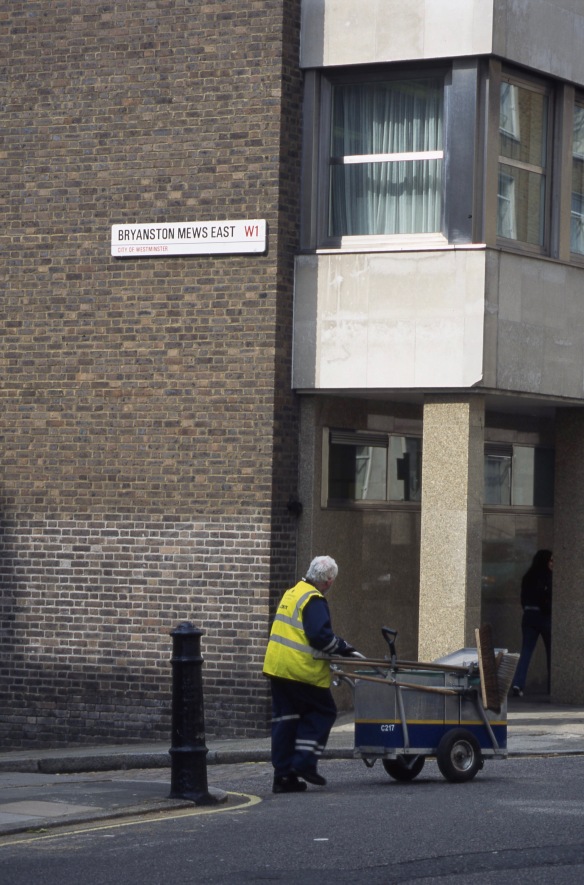CLICK ON IMAGES TO ENLARGE. REPEAT IF REQUIRED
..Today I scanned another batch of my Streets of London colour slide collection, this time from June 2004.
Warwick Crescent, W2 lies in the heart of Little Venice, as evidenced by the Regents Canal basin in the foreground. Much of this street was bombed during WW2. The building to which the street name is fixed is a survivor. One other, to the far left, out of the picture, is the 19th century Beauchamp Lodge, where I rented my counselling room. The rest consists of 1960s council building. We were bemused when, in the 1980s these boringly banal boxes began to be tarted up. The answers were probably revealed when the Council Leader’s gerrymandering exercise was exposed. The Waterside Café provided good snacks, cakes, and beverages; the Waterbus offered trips along the canal to Camden Lock and back. During my running years I sometimes exchanged waves with passengers as I jogged alongside them.
These steps taking pedestrians up from Porteus Street, lead to a bus stop at the large Harrow Road roundabout. To the left of the wall is the entrance to an underpass beneath the main thoroughfare. I knew people who would not use it for a not unreasonable fear of mugging. The trees at the top of the shot screen the canal.
Here is another shot of our friend the bemused window cleaner of Cabbell Street, NW1, which contained some rather beautiful mansion flats;
as does Old Marylebone Road;
a turning off which is Homer Row, W1. Traditional London taxi cabs are black. This driver chose red, and likes pink. The mansions shown above are reflected in his passenger window.
Regular readers will know that my self-imposed constraint on this series is that a street name sign must be included. I cheated a bit in this one, because it is Crawford Place, W2 that is featured, but St Mary’s Church, Marylebone, is actually in Wyndham Place, NW1. I was intrigued by the various examples of geometry on display in this scene.
Since this area is one of Westminster’s most prestigious, road sweeper, like this gentleman in Bryanston Mews East, W1, are rather more in evidence than in the poorer London Boroughs.
The embassy of the Republic of Angola is situated in Dorset Street W1 alongside the corner of Clay Street;
whilst on the corner of Dorset Street and Kenrick Place stands The Barley Mow, claiming to be the oldest pub in Marylebone. Time Out had this to say on 17th May 2013: “This corner pub in Marylebone started life in 1791 as a meeting place for farmers to pawn their goods. Legend has it that the wooden snugs (now listed) either side of the bar gave them a bit of privacy in which to make their transactions. These days, there’s a good range of lagers and bottled beers along with the ales, plus food (mainly Pieminster pies), with music in the evening mix.”
I wasn’t the only one with a camera on the go in Broadstone Place, W1.
The Tudor Rose pub on the corner of Blandford and Manchester Streets, W1 is featured in the London Pub Review website, thus: “Our dire predictions haven’t come true – this one’s still not changed in years. Good. It’s not a bad place at all, with decent beer on the hand pumps and proper pub grub served downstairs (upstairs there’s a restaurant) including such delights as Spam fritters. Being in a Marylebone backwater, this place hardly ever gets crowded, although there’s a weekday lunchtime trade, so if you need place for a quiet pint in the area, this place will do nicely. The service is prompt and friendly and the prices are on par for the area. Whilst you wouldn’t necessarily make a special effort to seek this place out, if you’re in the locale, do drop in. Oh, except on a Sunday – it’s closed.”
While I was working on this post, aromas of cumin and coriander led me to investigate the kitchen, where Jackie was occupied inventing her own cauliflower bahji,
which we were to enjoy for dinner with her classic lamb jalfrezi and basmati rice with onions and peppers.
































